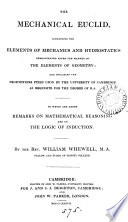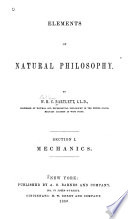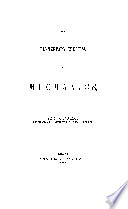 | John Farrar - Dynamics - 1825 - 492 pages
...lever in the contrary direction ; and the resultant of IL and IK', that is, of p, q, r, is IM. •i one direction, must be equal to the sum of the moments of those which tend lo turn it in the opposite direction ; "which may be expressed generally, by taking with contrary signs... | |
 | John Farrar - Dynamics - 1825 - 476 pages
...direction of the resultant, the moment of this force would be zero ; but, since it is equal to the sum of the moments of the forces which tend to turn the system in one direction, minus the sum of the forces tending to turn it in the opposite direction,... | |
 | Physics - 1829 - 500 pages
...conceived to be concentrated at its centre of gravity F. (12.) It is scarcely necessary to say, that if the sum of the moments of the forces which tend to turn the body round in one direction, be greater than the sum of the moments of the forces which tend to turn it... | |
 | William Whewell - 1837 - 226 pages
...moment. PROP. X. If any number of forces act upon a lever, and tend to turn it opposite ways, and if the sum of the moments of the forces which tend to turn the lever one way be equal to the sum of the moments of the forces which tend to turn it the other way,... | |
 | William Holms Chambers Bartlett - Mechanics - 1850 - 662 pages
...the projections of the farces on planes perpendicular to the axis. The sign of the moments of those forces which tend to turn the body in one direction, must be different from the sign of those which tend to turn it in an opposite direction ; in other words, if... | |
 | William Holms Chambers Bartlett - Astronomy - 1850 - 640 pages
...the projections of the forces on planes perpendicular to the axis. The sign of the moments of those forces which tend to turn the body in one direction, must be different from the sign of those which tend to turn it in an opposite direction ; in other words, if... | |
 | Gaspard Monge - Statics - 1851 - 228 pages
...that the direction of this resultant passes through the fulcrum, or, which amounts to the same, the sum of the moments of the forces, which tend to turn the lever in one direction around the fulcrum, is equal to the sum of the moments of those which tend to... | |
 | Isaac Wilber Jackson - Mechanics - 1852 - 202 pages
...— etc.. . . .[17] Thus, whatever the number of forces, the moment of the resultant is equal to the sum of the moments of the forces which tend to turn the system in the same sense as the resultant, minus the sum of the moments of the forces 35. If, in the... | |
 | Mechanics, Analytic - 1853 - 486 pages
...have the following Rule for estimating the effect of a given set of forces on a lever, viz. : Find the sum of the moments of the forces which tend to turn the lever one way, and the sum of the moments of those which tend the opposite way, and subtract the lesser... | |
 | Isaac Wilber Jackson - Mechanics - 1854 - 224 pages
...J"yV — etc [17] Thus, whatever the number of forces, the moment of the resultant is equal to the sum of the moments of the forces which tend to turn the system in the same sense as the resultant, minus the sum of the moments of the forces which tend to... | |
| |